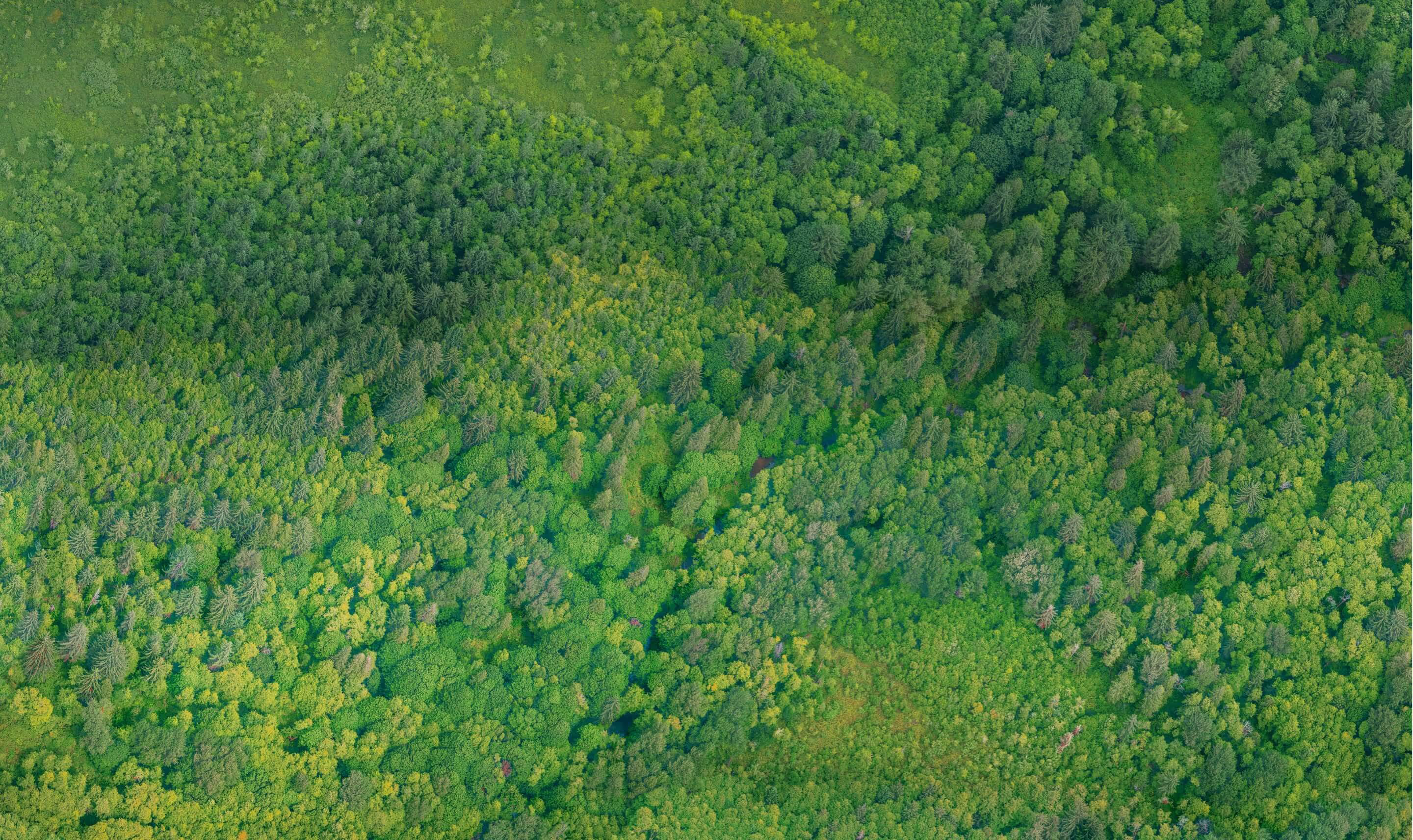How to implement effective reforestation? What does an ecological restoration expert think?
.avif)
To continue our series of interviews on the subject of reforestation, we asked Elise Buisson, expert in ecological restoration. Researcher and Senior Lecturer (HDR) at Avignon University, she is also part of the Natural and Cultural Heritage Restoration Engineering team within the Mediterranean Institute of Biodiversity and Marine and Continental Ecology (IMBE). His research applies to the conservation management and ecological restoration of ecosystems degraded by intensive agricultural practices.
1. What are the main strategies and methods used in ecological restoration through reforestation?
The main strategies
They are the same as for all restoration projects, whether forest or other ecosystems. They depend mainly on the initial state of degradation, the means available and the regenerative capacity of the ecosystem in question. There are three strategies:
Rehabilitation/reassignment
It is a process of making severely degraded land suitable for cultivation or a condition suitable for another purpose (i.e. an ecosystem different from the pre-degradation ecosystem — often the case of gravel pits).
Rehabilitation
It consists of management actions aimed at restoring a level of ecosystem functionality on degraded sites. The objective is the renewed and continuous supply of ecosystem services, rather than the biodiversity and integrity of a designated indigenous reference ecosystem.
Ecological restoration
It is a process that helps to restore an ecosystem that has been degraded, damaged or destroyed and that still concerns the preservation of biodiversity and ecological integrity. Other approaches to ecosystem restoration may focus only on providing ecosystem services (such as rehabilitation for example).
Did you know that? It must be clear that tree plantations for forestry or other landscape purposes are not restoration. Moreover, they should not be called forests because they do not function as forests. They are “simple” plantations. For example, the term Landes forest is not always appropriate. A small portion of the forest is actually a natural, mixed forest. A lot of it is actually just a plantation.

The various possible methods of forest restoration
The method chosen for the reconstruction of the forest (but which is also valid for other ecosystems) also depends on the capacity of the forest to regenerate, especially in its landscape context (fragmented or not).
Natural regeneration
Here, the degradation is stopped. Nature is then left to do its thing, without human intervention: the germination or any other recruitment of biotic elements (plants, animals and microorganisms) results from colonization, dispersion or a natural process In situ.
Assisted regeneration
It is an approach that is based on triggering the natural regenerative capacity of living organisms remaining on or near the site to be restored. It differs from the active reintroduction of living organisms to a site and from natural regeneration. This approach is often applied to sites with low or medium degradation. Assisted regeneration interventions include the suppression of pest organisms, invasive exotic species, or species that are undesirable or competitive with seedlings of naturally developing woody species, the restoration of disturbance regimes, and the provision of resources to accelerate colonization (for example, the installation of artificial perches for birds dispersing seeds).
When natural regeneration is weak, in certain highly anthropized landscapes (with a high activity of overgrazing, continuous wood extraction, bush fires or very fragmented), or on highly degraded soils and under certain unfavorable climates, it is then necessary to be more proactive in the restoration process. This can involve improving the soil (adding compost for example), planting trees, etc.

2. How to assess the suitability of an area for a reforestation project?
The key principle of a reforestation project
By definition, a reforestation project can only take place where a forest was present before degradation.
∙ Reforestation or reforestation refers to the restoration of a forest on land that was previously wooded.
∙ Afforestation or afforestation refers to the establishment of a forest on land that was previously not wooded.
Moreover, one could ask the question of the difference between reforestation and reforestation.
Some people use them as a synonym: reforestation = reforestation.
Others say that reforestation includes reforestation and afforestation. I think that this second solution is more confusing.
As I was able to write in the article” For reasoned reforestation ” from the magazine “Pour la Science”, setting up a new ecosystem where it did not exist before poses many challenges. In the absence of a pre-existing forest, the choice of trees adapted to this environment becomes difficult, thus increasing the risks of failure to install them. A striking example of these difficulties is illustrated by the work of Shixiong Cao of Minzu University of China, in Beijing, in 2008. His research has shown that attempts to reforest natural grasslands and steppes in semi-arid or arid regions of northern China to counter desertification have met with resounding failures. Only 15% of the trees planted survived. The main reason for this is the lack of water. In addition, the very presence of trees has resulted in a decrease in soil moisture, thus leading to a reduction in plant cover. Bare ground is exposed to intense wind erosion..
How to assess the suitability of a reforestation project?
So a good indicator is to know What ecosystem existed before the degradation did not take place. If it were from the forest, the 2E Indicator is The level of degradation. If the soil has been completely destroyed, planting trees does not make sense and it is therefore possible to opt for a reallocation (aiming at an ecosystem other than the forest). That said... it depends on the resources you put into it.
For example, following mining, if the soil has been preserved (stored), but not too long (it is better for it to maintain its properties), it can in this case be re-spread after exploitation to accommodate plantations. If the latter are diversified, if natural colonization is possible from the surroundings (i.e. there is some forest left in the landscape) then restoration can be relatively effective.

The case of fires
With regard to the level of degradation, it is interesting to mention that fire is a normal disturbance (we also say endogenous disturbance or environmental factor) for some ecosystems (and therefore not a degradation). In Mediterranean pine forests, scrub and scrubland, species are adapted to fire. Cork oak has thick bark to survive. Heathers, arbutus trees, kermes oaks have the ability to start from stumps. Aleppo pine has serotinous cones (which keep their seeds in the cone for several years, long after the seeds mature, and release them after exposure to fire). Rock roses, rosemary, etc. germinate after the fire has passed. So, in this type of ecosystem, after a fire has passed, the best thing is to do nothing and let nature regenerate itself, since it is adapted.
3. Is the massive planting of trees an adequate response to the challenge of climate change?
All natural/semi-natural ecosystems in good working condition store carbon.
We focus on trees because carbon is visible (the trunks are visible), while the carbon stored in peatland soils, for example, is not visible to the general public (same for meadows, posidonia meadows, etc.). It is therefore primarily a matter of perception, of ignorance.
I also think it's because it's easy at first glance. Anyone can plant a tree. Restoring a peatland that has been drained and cultivated... or replanting posidonia... it's much less so (and then... how many know what a peatland or a posidonia is?).
All natural/semi-natural ecosystems are necessary to maintain biodiversity and various ecosystem services.
La plantation d’arbres met ainsi la lumière sur la forêt (et encore… pas toujours, car beaucoup vont confondre forêt et plantation). Elle ne le fait pas sur les autres écosystèmes qui sont tout aussi importants pour le stockage du carbone, et qui comportent leur propre biodiversité et prodiguent des services écosystémiques bien spécifiques. Les plantations massives auraient pour résultat une homogénéisation des paysages et donc une perte massive de biodiversité et des services écosystémiques autres que le stockage de carbone (par exemple, les prairies fournissent de l’alimentation au bétail).
Alors que la plantation d’arbres peut être bénéfique dans les zones déboisées, elle peut être préjudiciable dans les écosystèmes naturellement herbacés, tels que les savanes ou les pelouses. Cette pratique détruit les habitats de nombreuses espèces végétales et animales, portant ainsi atteinte à la biodiversité et aux services écosystémiques cruciaux pour l’humanité. Ces écosystèmes fournissent des zones de pâturage et contribuent à la recharge des nappes phréatiques, soulignant ainsi l’importance de les préserver.
Par ailleurs, toutes les forêts ne sont pas équivalentes en termes de lutte contre le changement climatique. Les forêts de conifères des régions boréales et de hautes montagnes absorbent plus de lumière solaire et émettent plus de chaleur que les secteurs sans arbres. De ce fait, elles exacerbent le réchauffement planétaire plutôt que le réduire.
Le souci des plantations d’arbres « industrielles »
Emploi d’engins mécanisés fonctionnant à l’essence, perturbation des sols et donc émissions de CO2 qui y est stocké, utilisation de support en bois (qui ont nécessité une déforestation) pour maintenir les arbres, etc. La plantation d’arbres, si elle est faite de manière industrielle, peut aggraver le changement climatique en étant à l’origine de gaz à effet de serre. Elle peut aussi causer d’autres problèmes écologiques. Quand on parle de plantations massives, on utilise souvent des espèces exotiques ou un petit nombre d’espèces natives qui ne suffisent pas à créer une forêt. Ils produisent une plantation avec peu, voire pas, de bénéfice pour la biodiversité ou l’environnement.
L’importance de la restauration des écosystèmes forestiers sur le long terme
De plus, la plantation d’arbres pour lutter contre le changement climatique n’est utile que si cela est fait dans le cadre de la restauration d’écosystèmes forestiers sur le long terme. La plantation d’arbres pour l’exploitation entraine la destruction du carbone stocké (puisque les arbres sont prélevés et utilisés à un moment donné).
Les forêts naturelles et restaurées absorbent le CO2 atmosphérique, stockant une partie de ce carbone dans les arbres et le sol. Ce stockage est stable et peut durer des centaines d’années. En revanche, les plantations destinées à la production favorisent des espèces à croissance rapide et rentable commercialement, permettant un stockage rapide, mais éphémère de carbone. Le bois est souvent transformé en pâte à papier puis brûlé, libérant ainsi le carbone stocké dans l’atmosphère. Seule son utilisation dans la construction garantit un stockage durable du carbone.
Enfin, se focaliser sur la plantation d’arbres, risque de réduire la capacité des populations humaines à s’adapter au changement climatique tout en détournant l’attention des efforts de conservation des écosystèmes intacts, de réduction de la consommation de combustibles fossiles et/ou à la recherche de solutions plus efficaces.
La plantation d’arbres est à priori sans problème en milieu urbain.
4. Pouvez-vous partager des exemples de réussites notables de reboisement en tant qu’outil de restauration écologique ?
La forêt atlantique de Rio de Janeiro au Brésil
Au cours des XVI et XVII siècles, cet espace a été graduellement détruit par l’exploitation du bois et son remplacement par des fermes cultivant la canne à sucre et le café, ou par des pâturages pour le bétail. Dans la première moitié du XIXe siècle, comme la ville rencontrait de graves pénuries d’eau, l’empereur du Brésil Pedro II a demandé au major Manuel Gomes Archer de mener à bien un projet de regénération de la forêt, afin qu’elle puisse faciliter la formation de sources par pénétration de l’eau de pluie dans les sols. Ainsi, entre 1862 et 1874, 72 000 plantules ont été installées sur une zone à présent intégrée au parc national de Tijuca. Ce projet, maintenant vieux de 160 ans, était pionnier, car il a utilisé un grand nombre d’espèces différentes, principalement natives, et plantées de façon hétérogène.
En Fennoscandie
La gestion intensive des forêts y a simplifié le paysage forestier, menaçant la biodiversité. Pour sauvegarder cette dernière, il faut donc restaurer la complexité structurelle des forêts boréales jusqu’alors gérées. Les connaissances générées par des études de cas sur la restauration écologique suggèrent que le brûlage dirigé affecte positivement de nombreux organismes en début de succession. La création de trouées profite à certains insectes et champignons, mais a un effet limité sur les oiseaux, les bryophytes et les plantes vasculaires. La regénération des forêts de feuillus semble bénéficier aux espèces associées à la lumière et aux arbres à feuilles caduques, comme les insectes et certains oiseaux forestiers.
5. Quels sont les défis spécifiques rencontrés lors de la restauration d’écosystèmes via le reboisement, et comment les surmonter efficacement ?
Les bases d’un reboisement efficace
Il faut :
- Planter les bonnes espèces au bon endroit en maximisant l’hétérogénéité. Cet objectif est assez facile à atteindre si on implique les bonnes personnes en amont du projet.
- Que le projet soit bien intégré dans le paysage socio-économique et culturel et qu'il prenne en compte les besoins des populations locales. Cet objectif est plus difficile à atteindre dans certaines régions du monde où les communautés sont très dépendantes des ressources naturelles locales. Par exemple, si la population cuisine au feu de bois et que les arbres sont rares, la restauration écologique d’un patch de forêt a peu de chance d’être viable sur le long terme, car le bois sera prélevé trop fréquemment. Dans ce cas, il faut alors prévoir une plantation exploitable par la population pour ses besoins courants en plus de la reconstitution de la forêt.
Le cas de l’Europe
En Europe, c’est assez facile de reboiser correctement si on s'en donne la peine (voir plus haut l'exemple de la Fennoscandie). Cela dit, le recouvrement en forêt est naturellement en expansion dans de nombreuses zones en Europe du fait de la déprise agricole. Et comme discuté plus haut, la restauration n’est pas nécessaire (et peut même être contreproductive) après incendie pour les forêts adaptées au feu. Le reboisement en Europe va donc surtout concerner des forêts exploitées qu’il faut diversifier pour le bénéfice de la biodiversité, mais également pour limiter les dépérissements (dus à des carences, sécheresse, parasites, etc.)
Il est crucial de favoriser des plantations variées plutôt que monospécifiques, en combinant différentes espèces aux traits de vie variés. Par exemple, dans les régions tempérées, il faut mélanger des arbres à feuillage caduc ou persistant, des résineux et des feuillus, ou des espèces avec des systèmes racinaires différents. La réalisation de la plantation devrait être étalée sur plusieurs années pour encourager une structure complexe. Il est également essentiel de limiter l’utilisation d’espèces exotiques au profit d’espèces locales ou, éventuellement, d’espèces provenant de régions géographiquement proches. Cela garantit une meilleure adaptation au changement climatique sans compromettre l’équilibre des écosystèmes locaux.
6. Pourquoi les espèces indigènes sont-elles importantes dans les initiatives de reboisement ?
Comme dans tout projet de restauration (c’est-à-dire, quel que soit l’écosystème), l’utilisation d’espèces indigènes est primordiale. En effet, ce sont celles qui ont évoluées dans cet environnement particulier et qui vont pouvoir tisser des liens rapides et efficaces avec les autres espèces présentes localement ou qui vont recoloniser le site. Les réseaux trophiques vont pouvoir se régénérer plus facilement et l’écosystème devenir fonctionnel et résilient : par exemple, les espèces dégradant la litière de feuilles et assurant ainsi le cycle des nutriments dans l’écosystème restauré, ou celles consommant les fruits, dispersant les graines et permettant de ce fait la dynamique végétale, etc.
À l’inverse, l’utilisation d’espèces exotiques peut être à l’origine de problèmes environnementaux. Pour exemple, lors de la création du premier institut de foresterie aux Philippines en 1910, un plan de reforestation a été élaboré, incluant la plantation d’espèces indigènes et exotiques telles que l’acajou. Cependant, ce dernier, en produisant des graines annuellement contrairement aux espèces indigènes, a rapidement colonisé les espaces naturels, posant ainsi des problèmes environnementaux. De même, dans les Pyrénées à partir des années 1960, lors d’un programme de reboisement, les forêts de hêtres ont été remplacées par des épicéas, modifiant la composition de l’humus du sol et affectant la biodiversité, comme en témoigne la diminution des populations de collemboles (étudiés par ThierryGauquelin en 2004).
.avif)
7. Quels sont les critères clés pour évaluer le succès à long terme d’un projet de reboisement dans le cadre de la restauration écologique ?
Les critères les + utilisés sont (étude https://doi.org/10.1111/rec.12586 ) :
∙ La composition de la végétation, c’est-à-dire l’identité des espèces, le nombre d’espèces, le fait qu’elles soient indigènes ou exotiques, l’indice d’équitabilité (fréquence des différentes espèces), la survie des arbres plantés.
∙ La structure de la végétation, c’est-à-dire le recouvrement des différentes formes de vie (herbacées, plantules, arbustes, arbres), la hauteur des arbres, le diamètre à hauteur de poitrine, le recouvrement de la canopée. On peut aussi mesurer le nombre d’arbres morts sur pied et au sol et la qualité de la litière (mais c’est moins commun).
∙ La composition de la faune, c’est-à-dire le nombre d’espèces animales (souvent étudié par groupe [oiseaux, reptiles, etc.] et l’abondance de certains animaux.
∙ Le fonctionnement de l’écosystème qui implique d'étudier des paramètres physiques et chimiques du sol ou la présence de bio-indicateurs (par exemple le bio-indicateur de sols en bonne santé, et moins fréquemment le bio-indicateur de pollinisations ou de dispersion des graines).
8. Quelles synergies peuvent être développées entre les initiatives de reboisement et d’autres projets de conservation pour maximiser les avantages écologiques globaux ?
I think that in fact, there must be good communication between entities working in conservation and restoration on the same territory. If money needs to be spent on catering in a given territory, it is important to ask yourself the following questions:
- Are the conservation areas in good condition? Do they require restoration actions? Is that the priority?
- If conservation areas are in good condition, should restoration be aimed at increasing connectivity between existing areas or not?
9. How to ensure the long-term commitment and support of local communities in reforestation initiatives?
The most important thing is to bring local actors together as early as possible. of the project, to listen to the different opinions and to involve them in decisions at each stage. It is necessary to be involved in the scheduling, at the implementing And at tracking the success of the project over the long term. While participation in planning and implementation is important for ownership, I think that involvement in monitoring success is what will make it possible to maintain interest in the project and its protection over the long term.
There are entire textbooks that can help you learn more about this subject:
∙ MEOR, Methodology for Assessing Opportunities for Restoring Forest Landscapes: https://portals.iucn.org/library/node/45771
∙ Collaborative monitoring: https://www.cifor.org/knowledge/publication/7159
∙ Mapping social landscapes: a guide to identify the networks, priorities and values of restoration actors: https://www.wri.org/research/mapping-social-landscapes-guide-identifying-networks-priorities-and-values-restoration

Do you also want to take action for the planet? Join our Sapousse campaign ! Our reforestation projects fight against deforestation, preserve biodiversity and support local communities.



.avif)




